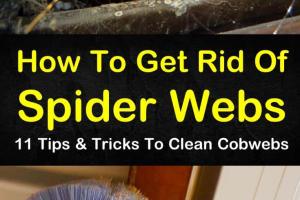How to Effectively Eliminate Spider Webs: Your Ultimate Guide

-
Quick Links:
- Introduction
- Understanding Spiders and Their Webs
- Why Remove Spider Webs?
- Tools and Materials Needed
- Step-by-Step Guide to Removing Spider Webs
- Natural Remedies for Spider Webs
- Preventing Spider Webs from Returning
- Case Studies and Real-World Examples
- Expert Insights on Spider Management
- FAQs
- Conclusion
Introduction
Spider webs can be an unsightly nuisance in your home and garden. While spiders themselves can be beneficial, helping control other insect populations, their webs often create a sense of discomfort and can detract from the aesthetic appeal of your space. In this comprehensive guide, we'll explore effective methods for getting rid of spider webs, understanding spider behavior, and implementing preventive measures to keep your spaces web-free.
Understanding Spiders and Their Webs
Before diving into removal techniques, it's helpful to understand the types of spiders that commonly inhabit our homes and gardens, along with their web structures. Common household spiders include:
- Common House Spider: Typically creates messy webs in corners.
- Orb-Weaver Spider: Known for its distinctive round webs.
- Black Widow: Recognizable by its black color and red hourglass marking.
Each type of spider has its own unique web-building habits and preferences for locations, which can affect how we approach their removal.
Why Remove Spider Webs?
There are several reasons for wanting to eliminate spider webs, including:
- Aesthetic Concerns: Webs can make spaces look unkempt.
- Allergies: Some individuals may be allergic to spider droppings or webs.
- Prevention: Removing webs can deter spiders from returning.
Tools and Materials Needed
To efficiently remove spider webs, gather the following tools:
- Vacuum cleaner with a hose attachment
- Long-handled broom or duster
- Microfiber cloths
- Spray bottle with a cleaner (optional)
Step-by-Step Guide to Removing Spider Webs
Follow these steps for effective spider web removal:
Step 1: Assess the Area
Identify areas where spider webs are prevalent. Look in corners, ceilings, and behind furniture.
Step 2: Prepare Your Tools
Gather your tools and ensure your vacuum is ready for use.
Step 3: Vacuum or Sweep
Using the vacuum hose, carefully remove webs from corners and ceilings. If using a broom, sweep gently to avoid scattering debris.
Step 4: Wipe Surfaces
Use a microfiber cloth to wipe down surfaces that may have spider residues.
Step 5: Clean Up
Dispose of any collected webs and debris. Clean your vacuum filter as needed.
Natural Remedies for Spider Webs
If you prefer natural solutions, consider these methods:
- Essential Oils: Mix peppermint or tea tree oil with water and spray in areas where spiders are common.
- Citrus Peels: Spiders dislike citrus scents, so placing peels can deter them.
Preventing Spider Webs from Returning
To keep your space spider-free:
- Seal cracks and crevices.
- Regularly clean corners and high surfaces.
- Maintain outdoor landscaping to reduce spider habitats.
Case Studies and Real-World Examples
Research conducted by pest control experts indicates that regular cleaning and maintenance can reduce spider populations by up to 50%. A case study in suburban neighborhoods found that homes with proactive cleaning measures saw significantly fewer spider webs within three months.
Expert Insights on Spider Management
According to entomologists, understanding spider behavior is crucial for effective management. They recommend:
- Identifying spider species to determine their habits.
- Using targeted approaches for removal and prevention.
FAQs
1. How often should I clean spider webs?
It is advisable to clean spider webs every few weeks to prevent buildup.
2. Are spider webs harmful?
Spider webs themselves are not harmful, but they can indicate a spider presence.
3. Can I use pesticides to remove spider webs?
While pesticides can kill spiders, they are not necessary for web removal and can be harmful to humans and pets.
4. How do I remove spider webs from hard-to-reach places?
Using a vacuum with a long hose or an extendable duster can help reach high areas.
5. What should I do if I find a black widow spider?
Contact a pest control professional immediately for safe removal.
6. Do spiders return after I clean their webs?
Spiders may return, but regular cleaning and preventive measures can greatly reduce their presence.
7. Can I prevent spiders from entering my home?
Yes, sealing entry points and keeping areas clean can help prevent spider infestations.
8. Are there any natural repellents for spiders?
Essential oils like peppermint or vinegar can deter spiders when sprayed around entry points.
9. How do I know if I have a spider infestation?
Signs include numerous webs, sightings of spiders, and spider droppings.
10. Is it safe to remove spider webs myself?
Yes, it is generally safe to remove spider webs, but caution should be exercised with venomous species.
Conclusion
Getting rid of spider webs involves understanding spider behavior, using effective removal techniques, and implementing preventive measures. By following the steps outlined in this guide, you can maintain a clean and spider-free environment in your home and garden.
External References
Random Reads